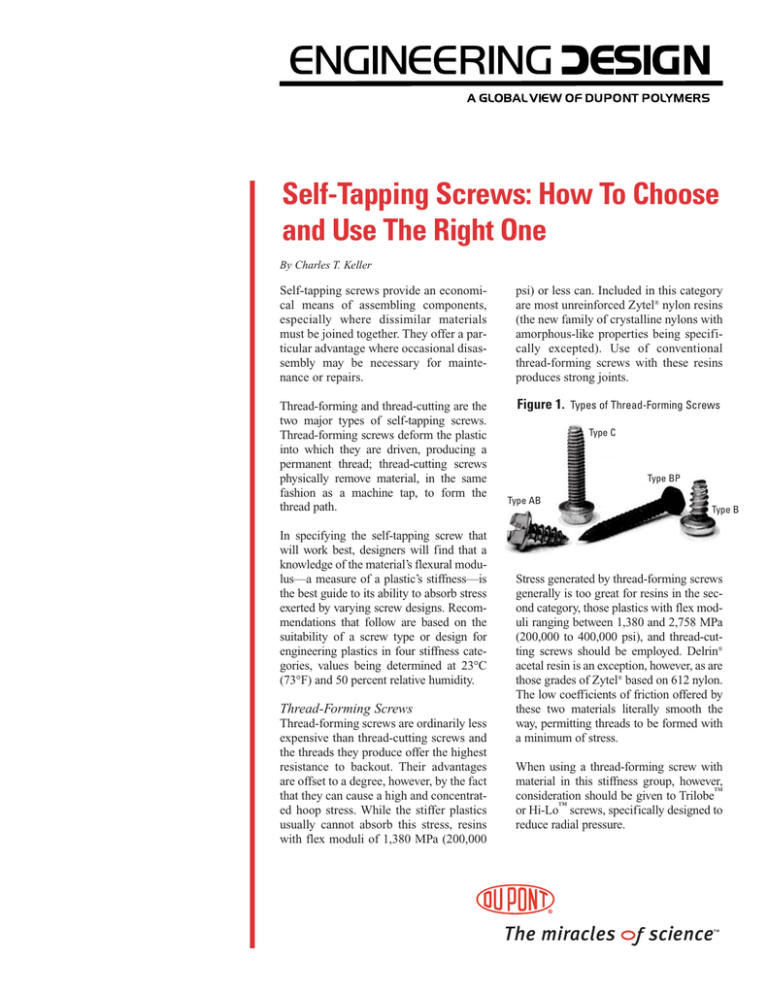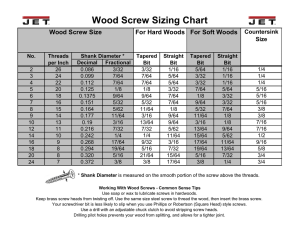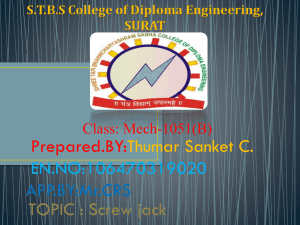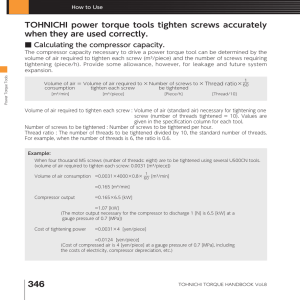Self-Tapping Screws: How To Choose and Use The Right One
advertisement

Self-Tapping Screws: How To Choose and Use The Right One By Charles T. Keller Self-tapping screws provide an economical means of assembling components, especially where dissimilar materials must be joined together. They offer a particular advantage where occasional disassembly may be necessary for maintenance or repairs. psi) or less can. Included in this category are most unreinforced Zytel® nylon resins (the new family of crystalline nylons with amorphous-like properties being specifically excepted). Use of conventional thread-forming screws with these resins produces strong joints. Thread-forming and thread-cutting are the two major types of self-tapping screws. Thread-forming screws deform the plastic into which they are driven, producing a permanent thread; thread-cutting screws physically remove material, in the same fashion as a machine tap, to form the thread path. Figure 1. Types of Thread-Forming Screws In specifying the self-tapping screw that will work best, designers will find that a knowledge of the material’s flexural modulus—a measure of a plastic’s stiffness—is the best guide to its ability to absorb stress exerted by varying screw designs. Recommendations that follow are based on the suitability of a screw type or design for engineering plastics in four stiffness categories, values being determined at 23°C (73°F) and 50 percent relative humidity. Thread-Forming Screws Thread-forming screws are ordinarily less expensive than thread-cutting screws and the threads they produce offer the highest resistance to backout. Their advantages are offset to a degree, however, by the fact that they can cause a high and concentrated hoop stress. While the stiffer plastics usually cannot absorb this stress, resins with flex moduli of 1,380 MPa (200,000 Type C Type BP Type AB Type B Stress generated by thread-forming screws generally is too great for resins in the second category, those plastics with flex moduli ranging between 1,380 and 2,758 MPa (200,000 to 400,000 psi), and thread-cutting screws should be employed. Delrin® acetal resin is an exception, however, as are those grades of Zytel® based on 612 nylon. The low coefficients of friction offered by these two materials literally smooth the way, permitting threads to be formed with a minimum of stress. When using a thread-forming screw with material in this stiffness group, however, consideration should be given to Trilobe™ or Hi-Lo™ screws, specifically designed to reduce radial pressure. 2 Figure 2. Trilobe™ Thread-Forming Screw Figure 3. Hi-Lo™ Thread-Forming Screw The Hi-Lo™ is available in both threadforming and thread-cutting types, with the latter recommended for use on materials with an even higher flex modulus. The HiLo™ thread forming fastener has a double lead thread where one thread is high and the other low. A sharp 30 degree thread angle allows for a deeper cut into the material and reduces the radial stress that would be generated by a conventional 60 degree thread angle form. Its smaller than conventional minor diameter increases the material in contact with the thread. The result is a stronger fastener with greater resistance to pull out. Thread-Cutting Screws A third group of resins, with flex moduli in the 2,758 to 6,895 MPa (400,000 to 1,000,000 psi) range, gain strength—and stiffness—from glass fiber and/or mineral reinforcement. Resins in this category include glass-filled Delrin® 570; those compositions of Zytel® nylon reinforced with up to 13 percent (by weight) glass fibers; and Minlon® mineral reinforced nylon. Rynite® 430, a toughened, 30 percent glass reinforced member of DuPont’s family of PET polyester resins, although it has a slightly higher flex modulus—7,590 MPa (1,100,000 psi)—also fits in this grouping because of its ability to accept conventional thread-cutting screws. 2. Molded-in inserts, shaped to minimize stress, are prepositioned directly in the mold and become an integral part of the component. In these stiff materials, thread-cutting screws will have high thread engagement and high clamp loads. They will not induce high residual stress that could cause product failure after driving. Figure 7. The last group of plastics, those with flexural moduli above 6,895 MPa, are relatively brittle. Their tendency to granulate between screw threads can cause fastener pull-out at lower than predicted force values. Resins in this very stiff category are the 33 and 43 percent glass-reinforced Zytel® nylons and all other grades of Rynite® polyester. For these very stiff resins, the finer threads of a T-type threadcutting screw are recommended. Figure 5. T-Type Screw Type D Type BT Figure 8. Expansion Insert 4. Solid bushings are generally two-piece inserts. The body is screwed into a prepared hole and a ring locks it in place. Figure 9. Other Important Factors Even when fine pitch screws are used in these very stiff plastics, threads will usually shear when the screw is backed out. If fastener removal and reinstallation are required, the boss should be large enough to accommodate a replacement screw in the next larger diameter. Larger screws used for repairs will provide greater clamp loads than the original installation. Metal Inserts An alternate and longer lasting solution would be the use of a threaded metal insert. Four types of inserts are commonly used: ultrasonic, molded-in, expansion, or solid bushings. Friction and pressure against the outer knurls and grooves hold an insert in place. The tapped inner hole accepts a standard machine screw. When designing for self-tapping screws, a number of factors are important: • Boss Hole Dimension—For the highest ratio of stripping to driving torque, use a hole diameter equal to the pitch diameter of the screw. • Boss Outside Dimension—The most practical boss diameter is 2.5 times the screw diameter. If its wall is too thin, a boss may crack. Higher stripping torques are not achieved with thicker bosses. • Effect of Screw Length—Stripping torque increases rapidly with increasing length of engagement and levels off when the engaged length is about 2.5 times the pitch diameter of the screw. Strip-To-Drive Ratio Type T 1. Ultrasonic inserts are pressed into place as the plastic is melted by high-frequency ultrasonic vibrations. It becomes secured as the melt solidifies. This is the preferred installation for DuPont engineering plastics. Figure 6. Type BF 3. Expansion inserts are slipped into premolded or drilled holes, locking in place as the screw expands the insert. Solid Bushing Figure 4. Thread-Cutting Screws Type F Molded-In Insert Ultrasonic Insert The torque-turn curve in Figure 10 shows how a self-tapping screw responds to applied torque. Up to point “A”, driving torque is applied to cut or form a thread and to overcome sliding friction on the threads. Successive turns require more torque as the area of thread engagement increases. At point “A”, the head of the screw seats. Any further application of torque—now referred to as stripping torque—results in compressive loading of 3 the threads. At point “B”, stress in the threads reaches the yield point of the plastic, and the threads begin to shear off. Threads continue to strip off to point “C” when the fastening fails completely. Strip-to-drive ratio—the ratio of stripping torque to driving torque—can be used to evaluate the performance of a fastened joint. For high volume production with power tools, this ratio should be about 4 to 1. With well trained operators working with consistent parts and hand tools, a 2 to 1 ratio may be acceptable. In any case, lubricants must be avoided because they drastically reduce this ratio. Figure 10. Torque-Turn Plot The ultimate test of a self-tapping screw is the pull-out force. It can be calculated from; Verification can be obtained by running prototype tests on boss plaques or flat plaques molded in the plastic selected. Trilobe™ is a trademark of Continental Screw Co. Hi-Lo™ is a trademark of Illinois Tool Works, Inc. C.T. “Chuck” Keller, senior technical specialist in the design group at Polymer Products Department’s Chestnut Run Technical Services Laboratory, takes a look at screw types, plus some viable alternatives, and offers some tips on boss design and joint evaluationThis article was originally published in the Spring 1983 issue of “Engineering Design” magazine.




